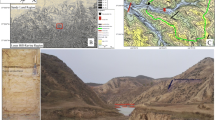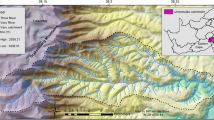Abstract
Tracing erosion flux within a single catchment is one of the major targets for the Earth’s Critical Zone science. The sedimentary succession in landslide-dammed reservoirs within the Chinese Loess Plateau (CLP) serves as a valuable archive of past erosion history. Deposition couplets and annual freeze–thaw layers were firstly identified for the sedimentary succession of the Jingbian reservoir on the northern CLP with high-resolution XRF core scanning. The deposition couplets in the reservoir since 1963 A.D. were further dated with 137Cs activity. We found consistent one-to-one correspondence between couplet specific sediment yield and storm intensity. The reconstructed soil erosion history highlights the control of storm intensity and frequency on loess erosion on the northern CLP in the past hundreds of years.
Similar content being viewed by others
Avoid common mistakes on your manuscript.
1 Introduction
The Chinese Loess Plateau (CLP) is characterized by one of the most rapidly and severely eroded areas on Earth. The soil erosion and transport on the CLP, shaping its own surface and affecting the structure and function of ecosystems and the surrounding societies (Wang et al. 2016a, b), have varied under various natural and anthropogenic agents. Therefore, it is significant to trace erosion and transport processes within an Earth’s critical zone on the CLP. However, the flux of erosion on the CLP was assessed previously by sediment loads from the Yellow River and their tributaries (e.g. Wang et al. 2010; Yu et al. 2013). Little is known about erosion flux and the processes within a single catchment on the CLP, which is related with soil properties, landscape, vegetation, and runoff. One of major challenges is how to obtain well-dated sedimentary records.
The sediments trapped in the natural landslide-dammed reservoirs or anthropogenic check dams are characterized by deposition couplets and thus provide a valuable archive of catchment erosion rates, past climate and eco-environmental conditions on the CLP (e.g. Zhang et al. 2009; Wang et al. 2016b). In this study, after the identification of deposition couplets and annual freeze–thaw layers for the sedimentary succession of the Jingbian reservoir on the northern CLP were determined through high-resolution XRF core scanning, the 137Cs activity in the fine-grained layer was used to date deposition couplets, as137Cs is prone to being absorbed by fine particles (Zhang et al. 2006). The dated couplet was confirmed by a consistent one-to-one correspondence between single deposition couplet and single storm event. Finally, the reconstructed soil erosion history in the past hundreds was related to storm intensity and frequency on the northern CLP.
2 Materials and methods
A 22.25 m long sediment core with a diameter of 10 cm was drilled at the depositional centre of the Jingbian reservoir (37°18′N, 108°36′E, 1560 m.a.s.l.) in May 2013. Clays and silts with clear layers dominate the entire core sequence. The core sections were scanned lengthwise with a step size of 2 mm using an Avaatech XRF core scanner at Lanzhou University to obtain the elemental distributions of the sediments.
After the identification of deposition couplets and annual freeze–thaw layers for the Jingbian sedimentary successions, 37 dry powder samples from the fine-grained layers of the uppermost section were measured for 137Cs activity using gamma-ray spectrometry with a LOAX HPGe at Institute of Mountain Hazards and Environment, Chinese Academy of Sciences, following the procedures by Zhang et al. (2006), with errors less than 6%.
3 Identification of deposition couplet and annual freeze–thaw layer
The deposition couplet is a typical structure in landslide-dammed reservoir sedimentary succession on the CLP and it is composed of an underlying coarse layer and an upper fine layer as a result of the sorting and stratification processes during an individual storm event. The numbers and specific sediment yield (SSY, i.e. erosion flux) of the couplets mainly depend on the frequency and intensity of storms, respectively. The SSY of each couplet is calculated by couplet thickness, catchment surface area, gully slope, and bulk density. Among the couplets of an individual year, there may be a freeze–thaw layer that is commonly formed within the last fine-grained layer of the sediments during the cold winter and the following warm spring, which is considered to be the boundary of the last hydrological event in a year (Zhang et al. 2009; Wang et al. 2016b). The numbers and SSYs of the deposition couplets between two annual freeze–thaw layers represent the frequency and intensity of large hydrological events within a given year. If there is no couplet between any two annual freeze–thaw layers, that means no large hydrological events occurred during that year, i.e. it was a drought year or the ground was dry during freezing.
Following the way for identifying annual freeze–thaw layers among deposition couplets by Wang et al. (2016b), Rb/Zr ratio by high-resolution XRF core scanning was employed as an excellent geochemical proxy to plot out deposition couplets (Fig. 1). In fact, Rb/Zr ratios reflect variation in grain size during the sorting and stratification processes during the formation of each deposition couplet, i.e. Rb enriches in the upper fine layer, whereas Zr in the underlying coarse layer (Dypvik and Harris 2001; Chen et al. 2006; Liang et al. 2013); both are unaffected by the freeze–thaw processes. According to Rb/Zr ratio distributions, 126 deposition couplets were identified in the Jingbian succession, indicating that there were 126 storms or floods since the formation of the reservoirs. Furthermore, 77 annual freeze–thaw layers were identified in the sedimentary succession by the correlations of Ca/Zr and Fe/Zr.
4 137Cs activity, erosion flux and storm
According to the 137Cs activity distribution of the fine-grained layers in deposition couplets on the Jingbian sedimentary succession, the 30th couplet from the land surface in the Jingbian reservoir was deposited following a storm around 1963 A.D. (Fig. 2). Based upon the meteorology records from the Jingbian and Wuqi counties, exactly thirty storms have happened since 1963 A.D., with a one-to-one correspondence with the recent thirty deposition couplets identified by Rb/Zr ratios. One important observation is that the intensity of a storm is further correlated with the erosion flux of each couplet, i.e. SSY (Fig. 3). For example, the strongest storm on August 10, 1994 corresponded to the thickest couplet since 1963 A.D. (Fig. 2). The correlation coefficient (r 2) between the storm discharge and SSY of the recent 30 couplets is 0.75 (Fig. 3). Two AMS 14C datings of plant residues also support the correspondence (Fig. 2).
Based on the identification of the annual freeze–thaw layers, r 2 between the storm discharge and SSY, and the SSYs of couplets, the Jingbian 22.25 m succession records the erosion and storm history during the period between 1855 and 2013 A.D. During the period within the Jingbian reservoir, the total sediment yield reached to 5.13 × 106 t, with 4.07 × 104 t of an individual couplet and 3.35 × 104 t of the mean annual yield; SSY of an individual couplet and annual SSY were averaged as 1.42 × 104 t/km2 and 1.12 × 104 t/km2/year, respectively. These erosion changes within the catchments on the northern CLP should be a coupled result of both contemporary storms and human activities.
References
Chen J, Chen Y, Liu L et al (2006) Zr/Rb ratio in the Chinese loess sequences and its implication for changes in the East Asian winter monsoon strength. Geochim Cosmochim Acta 70:1471–1482
Dypvik H, Harris NB (2001) Geochemical facies analysis of fine-grained siliciclastics using Th/U, Zr/Rb and (Zr + Rb)/Sr ratios. Chem Geol 181:131–146
Liang L, Sun Y, Beets CJ et al (2013) Impacts of grain size sorting and chemical weathering on the geochemistry of Jingyuan loess in the northwestern Chinese Loess Plateau. J Asian Earth Sci 69:177–184
Wang H, Bi N, Saito Y et al (2010) Recent changes in sediment delivery by the Huanghe (Yellow River) to the sea: causes and environmental implications in its estuary. J Hydrol 391:302–313
Wang S, Fu B, Piao S et al (2016a) Reduced sediment transport in the Yellow River due to anthropogenic changes. Nat Geosci 9:38–41
Wang X, Jin Z, Chen L et al (2016b) High-resolution X-ray fluorescence core scanning of landslide-dammed reservoir sediment sequences on the Chinese Loess Plateau: new insights into the formation and geochemical processes of annual freeze–thaw layers. Geoderma 279:122–131
Yu Y, Huang H, Shi X et al (2013) New discharge regime of the Huanghe (Yellow River): causes and implications. Cont Shelf Res 69:62–72
Zhang X, Walling DE, Yang Q et al (2006) 137Cs budget during the period of 1960s in a small drainage basin on the Loess Plateau of China. J Environ Radioact 86(1):78–91
Zhang X, Walling DE, He X et al (2009) Use of landslide-dammed lake deposits and pollen tracing techniques to investigate the erosional response of a small drainage basin in the Loess Plateau, China, to land use change during the late 16th century. Catena 79:205–213
Acknowledgements
This work was financially supported by the 973 Program (No. 2013CB956402) and National Natural Science Foundation of China (No. 41225015).
Author information
Authors and Affiliations
Corresponding author
Additional information
11th International Symposium on Geochemistry of the Earth’s Surface (GES-11).
Rights and permissions
About this article
Cite this article
Jin, Z., Wang, X. & Zhang, X. Dated deposition couplets link catchment erosion flux with storm discharge on the Chinese Loess Plateau. Acta Geochim 36, 548–551 (2017). https://doi.org/10.1007/s11631-017-0233-8
Received:
Revised:
Accepted:
Published:
Issue Date:
DOI: https://doi.org/10.1007/s11631-017-0233-8







